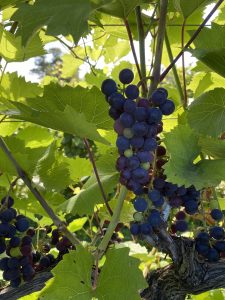Wisconsin Vineyard Update: Veraison Disease Management

Many southern Wisconsin vineyards are entering veraison (fruit ripening), especially on early varieties. This is a critical stage for the grapes and for disease management. After veraison, grape clusters become more vulnerable to some diseases such as sour rot and bunch rot and become less susceptible to powdery mildew and downy mildew infections due to ontogenic or age-related resistance. However, while the fruits eventually become resistant to powdery mildew and downy mildew (typically 6-8 weeks post-bloom), the foliage remains susceptible to powdery mildew and downy mildew all season long, even after harvest.
Botrytis bunch rot primarily affects French hybrid and Vitis vinifera grape varieties. It is not very common in Midwest vineyards, but it can affect tight-clustered grape varieties. Preventative fungicide applications should start at bloom, and again at bunch closure. Applying fungicides during veraison is important to prevent Botrytis, but once this stage passes, controlling the disease becomes more challenging.
More commonly observed in our cold climate varieties is sour rot, a late-season grape disease that typically occurs near harvest on berries that have been damaged by birds, rain splitting, or insects. Sour rot does not become a problem until the berries reach about 15 Brix. Higher temperatures can greatly increase the rate of development. Fruit flies (Drosophila) also play a key role in the disease cycle and should be controlled in addition to the yeast and bacteria associated with sour rot.
Warm and humid weather can promote the spread of pathogens. While it’s been an extremely dry season, recent rains have increased humidity and conditions may be conducive for fungal pathogens. Cluster thinning during veraison can aid in disease management. Reducing cluster density allows better airflow and sunlight penetration, which can decrease the chances of disease development. When it comes to chemical management of diseases at veraison, be mindful of pre-harvest intervals and prioritize products with short PHIs closer to harvest.
Pre-Harvest Disease Management Considerations:
- When making fungicide applications, always follow the recommended pre-harvest intervals as specified on the product labels.
- Promote better airflow in the grapevine canopy utilizing practices like shoot thinning and leaf removal. Increased airflow helps create an environment less favorable for pathogens.
- Pay attention to the grape maturity, and avoid delaying the harvest, which could lead to increased disease risks.
- Bird netting will help minimize bird damage, but it can also impact the penetration of fungicide chemistries in the canopy.
Additional resources:
- Fruit and Cluster Rots https://fruit.wisc.edu/2022/09/15/wisconsin-grape-harvest-fruit-and-cluster-rots/
- Midwest Fruit Pest Management Guide: https://ag.purdue.edu/department/hla/extension/_docs/id-465.pdf
- NEWA Grape Disease Models: https://newa.cornell.edu/grape-diseases/

